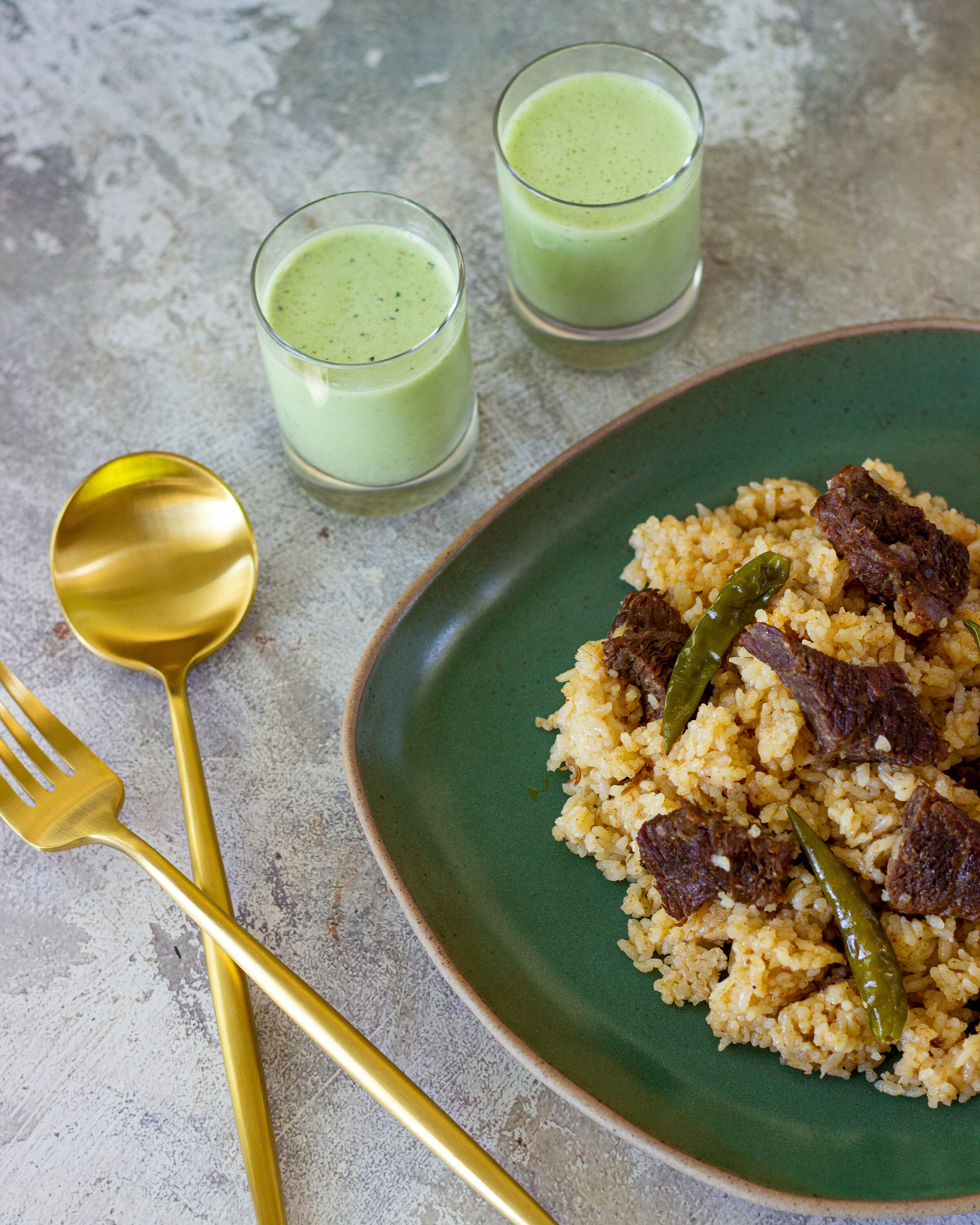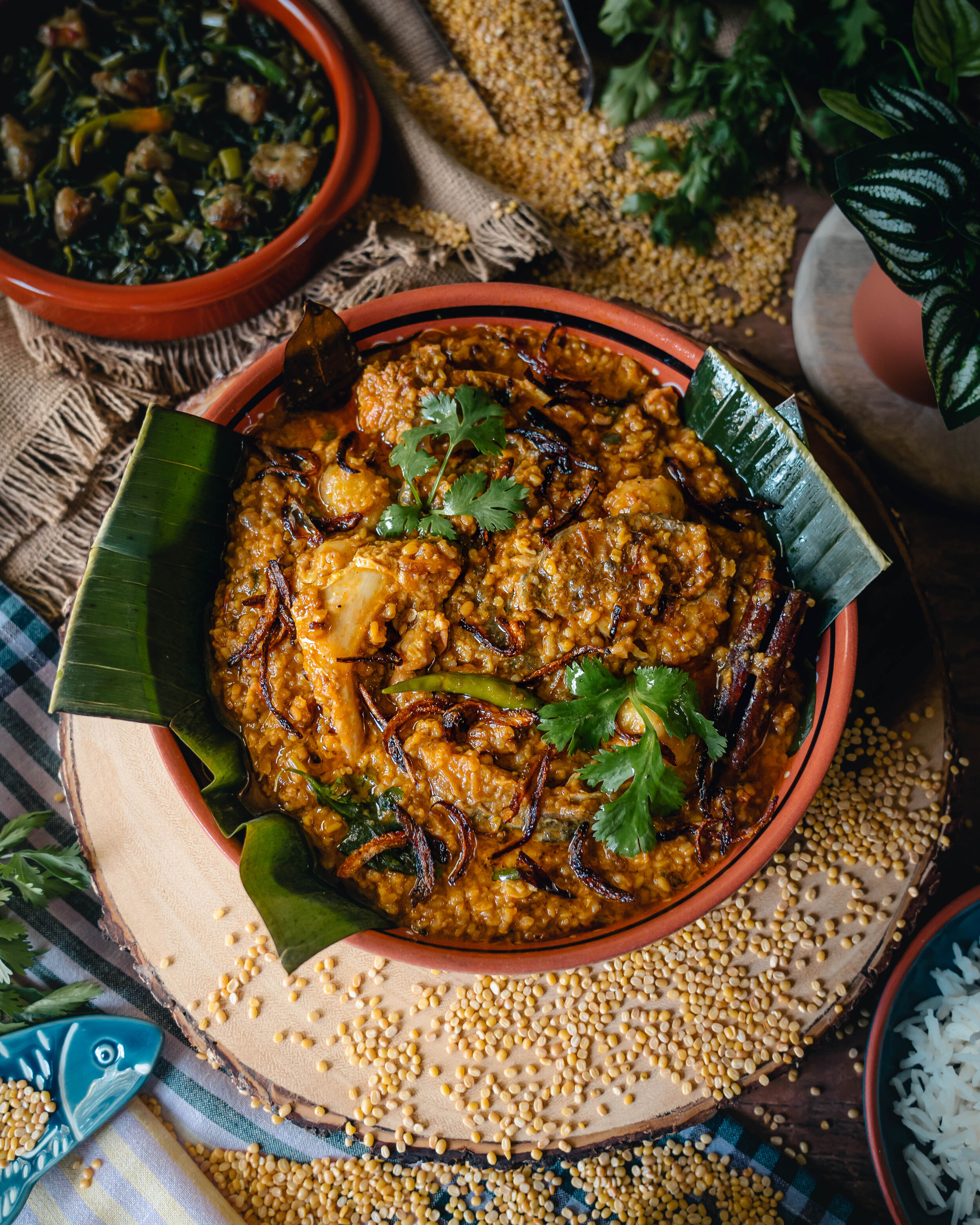Puran Dhakar Tehari

Tehari is an authentic Bangladeshi dish of aromatic rice and meat pilaf packing a fiery and flavorful punch.
It’s a dish of Awadhi origin from India called Tehri, which traditionally consisted of yellow rice and potatoes, like a vegetable biryani. It was developed for the Hindu bookkeepers of the Muslim Nawab rulers in South Asia. Tehri became more popular during the Second World War when meat prices increased substantially and potato became the popular substitute in biryani. The Bangladeshi version Tehari is unique in the sense that unlike it’s original prototype, ours is non-vegetarian and consists of short grain aromatic rice, combined with curried meat, cooked in mustard oil and lots and lots of fresh green chilies.
In the book, Dhaka Pachas Baras Pehle, Hakim Habibur Rahman refers to this dish as Tahiri, eaten during breakfast and brunch. Nowadays, it is a sought after street food in Puran dhaka, the historic old part of the city known for it’s mughal influence. Puran Dhaka used to be called Jahangir Nagar named after the Emperor Jahangir and it was established as the capital of Mughal Bengal in 1608. The old city is now a heritage site and a food landmark renowned for biryani, morog polau, kababs and many more delectable dishes, including tehari. The most famous Bangladeshi tehari can be found in one of the oldest restaurants in the heart of Puran Dhaka known as Haji Biryani, where they have been serving the exact original tehari recipe since 1939. If you want my version of the fabled tehari recipe inspired by Haji Biryani, keep scrolling.
Biryani vs Tehari
The difference between biryani and tehari lies in the cooking method, ingredients and the fat content. Biryani usually consists of long grain basmati rice, meat and potatoes, which are all cooked separately mainly in ghee, using both ground and whole spices. The rice, spiced fried potato and meat curry are layered during the final cooking process and gently cooked after the lid is sealed with dough, a traditional cooking process called dum pukht. Biryani also includes dried sweet fruits like aloobokhara, raisins, sometimes even cashew nuts, and usually garnished with beresta, crispy fried onions.
Tehari on the other hand is traditionally red meat cooked in mustard oil and ground spices, and then short grain rice is cooked in the leftover gravy from the meat curry. In the final step, rice is combined with the meat curry and lots of fresh green chillies, then gently cooked on low flame.
Both biryani and tehari is traditionally served with borhani, a spiced yogurt drink made of coriander, mint and green chillies. In our household, we prefer tehari over biryani because of its’ ease of eating. At some point white eating biryani, we have all unknowingly bit into a giant black cardamom and woefully regretted the taste. With tehari, it doesn’t hurt because all the spices are ground up and you don’t spend all your time trying to remove all the generous helping of whole spices while your food turns cold. Personally for me, tehari has all the spicy flavors like mustard oil and green chillies which are synonymous with Bengali and Bangladeshi culture and it’s something I grew up eating.
Ready for the recipe?
Puran Dhakar Tehari
Old Dhaka’s Beef & Rice Pilaf
Serves 6-8
Preparing the Meat
Beef/Lamb 500g - well marbled chuck with decent fat or shank meat
Beef/Lamb Shank Bones - 100-200 g, I like to add bones for extra flavor
In this recipe, we will be using beef. Cut the meat into small bite size pieces and set aside with the bones.
Note: Bones will add flavor to your meat curry. As the bone heats the juice from the marrow (which is rich in fat and gelatin) will release and immerse into the meat; making for a flavorful and rich meat curry.
Tehari Spices
Cardamom Seeds- 3 Tsp
Cinnamon - 3 Sticks
Nutmeg - Half/1 Tsp powder
Mace - 2 pcs/1 Tsp powder
Cumin - 2 Tsp
Coriander - 2 Tsp
Bay Leaves - 1 large
Red Chilli Powder - 2 Tsp
Black Cardamom - 1
Black Cumin Seeds - 1 Tsp
Grind all the spices and set aside.
Note: Do not roast the spices before making the powder. Tehari requires unroasted spices.
Mustard Oil ¼ cup
Vegetable Oil ¼ cup
Heat mustard oil and vegetable oil in medium-high heat.
Note: Mustard oil adds a fiery and distinctive pungent taste which makes Bangladeshi tehari unique. If you love the taste, you can leave out the vegetable oil entirely and use ½ cup mustard oil. If you can’t find mustard oil or don’t like the flavor, use ½ cup Vegetable Oil.
Onion - ½ cup sliced
Ginger Paste - 2 Tbsp
Garlic Paste - 2 Tbsp
Green Chillies - 5, chopped and mashed
Salt - 1 Tbsp
Saute onions until it starts to turn golden. Add ginger paste, garlic paste and mashed green chillies and continue sauteing for another 1-2 minutes. Add the salt and tehari spices, combine well. Add 1/2 cup hot water to make sure the spices don't burn. Then add the beef and saute until color changes and the water is completely reduced.
Yogurt - 3 Tbsp
Sugar - 1 Tsp
Mix the yogurt and sugar well. Add it to the beef and cook it down. Once the gravy has reduced and thickened, oil will come up. Add 2 cups of hot water, turn the heat down to medium-low and let the beef gently cook for 45 minutes. Make sure to stir in between so the bottom doesn't burn. Once the meat has cooked it should have a decent amount of gravy. Pull the meat aside in a separate bowl leaving out most of the gravy. We are going to use the remaining oil and gravy in the pot to prepare the rice.
Preparing the Rice
Rice - 2 ½ cups, Kalijeera/Chinigura is used traditionally, if you don't have use Basmati
In medium heat toast the rice in the remaining oil and gravy until it turns from white to a light brown color. Stir often and make sure not to let the bottom burn, should take 3-4 minutes.
Hot Water - 3 cups
Hot Milk - 1 cup
Salt - 1 Tsp
Add the hot water, hot milk and salt, mix well and turn the heat to high. Taste for salt, it should be a tad bit saltier so when the rice is fully cooked it absorbs all the salt. Let the rice come to a boil.
Assembling the Rice and Meat
Fresh Green Chillies - 8-10 pcs, you can put less if you don’t like it spicy
Kewra Water - 1 Tsp
Ghee - 1 Tbsp
When the rice and the water are on the same level, add the meat mixture and green chillies. Mix everything gently using a rubber spatula. Do not break the rice. Cover the lid. Turn the heat down to low and let everything cook in low steam, it should take another 40 minutes. Once in a while come and check on the rice, to make sure the bottom doesn’t burn. You can also fluff the rice using a fork so the rice doesn’t break. Once the rice is fully cooked and all water is absorbed, top it off with kewra water and ghee. Mix it gently using a rubber spatula or fork, turn off the heat and close the lid. Let it rest until you are ready to serve.
Tehari tastes best with a cold glass of borhani, and a side of sliced cucumbers, sliced shallots and a couple lime wedges.







